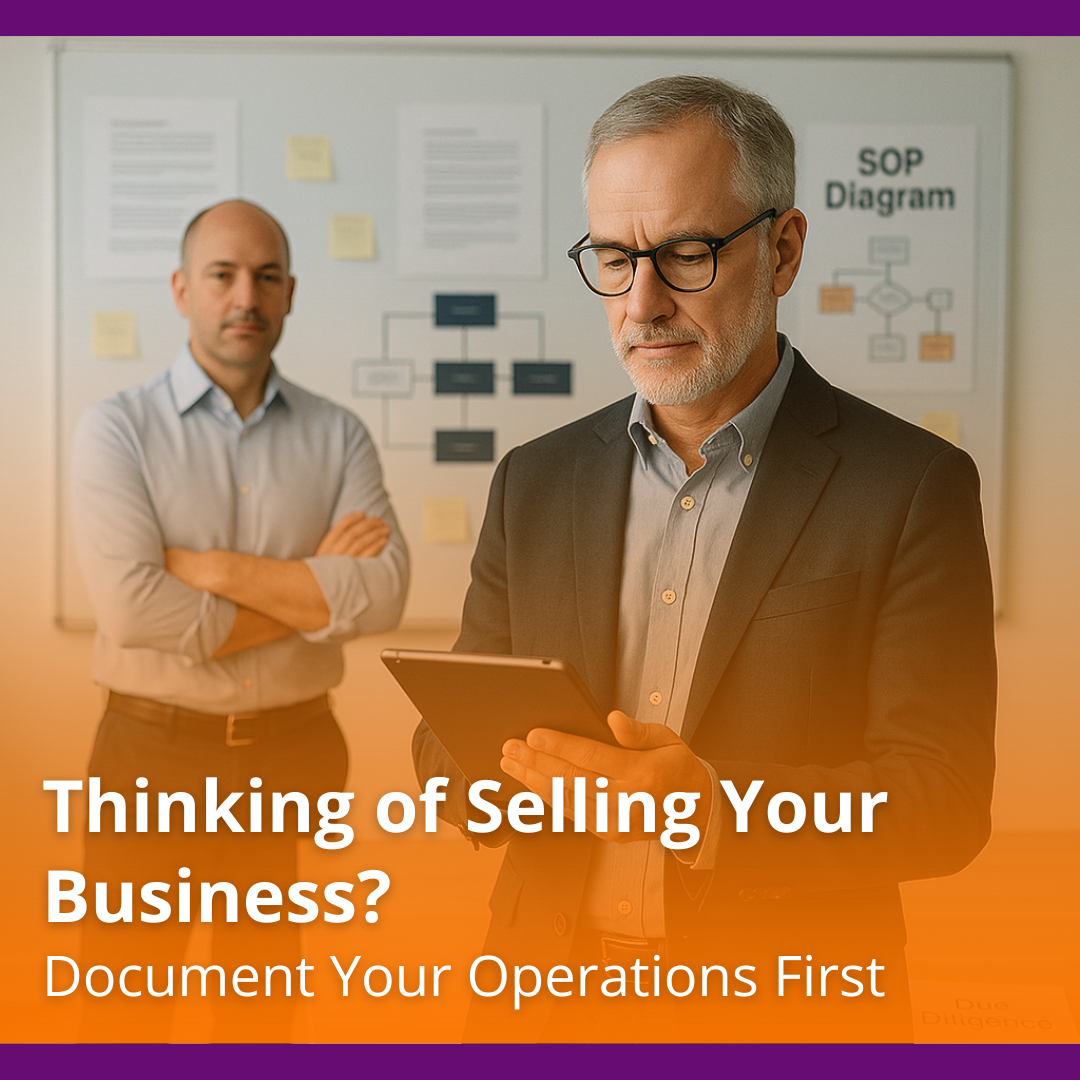Thinking of Selling Your Business? Document Your Operations First
Running a business means knowing every moving part. But to a buyer, that knowledge means nothing if it isn’t documented. And that’s a...
Comprehensive, data-driven valuations and comparative equity analyses to accurately price your practice, establish market benchmarks, and support informed decision-making.
Comprehensive M&A guidance encompassing deal structuring, negotiation strategies, market listings, and transaction closings.
Comprehensive systems, targeted coaching, and in-depth assessments designed to optimize operational efficiency and enhance advisory team effectiveness.
Strengthen continuity through the implementation of formal continuity agreements, the establishment of legal entities, execution of enforceable legal contracts, and securing appropriate capital resources.
5 min read
 Anthony Whitbeck, CFP®, CLU®
October 24, 2025
Anthony Whitbeck, CFP®, CLU®
October 24, 2025

The M&A landscape in financial services isn’t slowing down. It’s evolving. Fast.
As of mid-2025, deal values in the sector have surged by 15% year-over-year, even as total deal volume declined slightly. Buyers are shifting focus from quantity to quality, prioritizing scalable, tech-forward firms with clear succession plans (PwC).
For financial advisors, this signals a critical inflection point. Whether you’re looking to grow, merge, or eventually exit, your firm is already being measured by acquirers, partners, and the competition. The question isn’t whether M&A will impact your practice. It’s whether you’re positioned to benefit from it or be left behind by firms that are.
In this article, we’ll break down the major M&A trends shaping the financial services sector in 2025 and explain what they mean for advisors ready to take the next step.
M&A activity across the financial services sector continues to evolve, not decline. While the number of transactions has dipped slightly in the first half of 2025 compared to 2024, overall deal value has increased, pointing to a market focused on quality over quantity. Advisory firms with clear growth strategies, strong tech foundations, and exit readiness are driving most of the acquisition interest.
The wealth management industry is seeing a wave of consolidation. Larger firms are absorbing smaller competitors to gain scale, cut costs, and expand into adjacent services. This isn’t a short-term trend. It’s a shift in how advisory services are structured for the next decade.
This is not just a surge in M&A activity. It’s a strategic reshaping of the financial institution space. Advisors who understand the evolving M&A environment, from valuation levers to buyer preferences, can position themselves for stronger outcomes. Those who don’t risk falling behind in an increasingly selective market.
The second half of 2025 promises continued momentum rather than a slowdown. M&A dynamics are evolving, and understanding which trends are gaining traction is essential for navigating the changing competitive and valuation landscape in advisory firms.
M&A activity in financial services is increasingly focused on larger, more scalable platforms. According to PwC, large deals continue to lead the way in financial services M&A in 2025, putting pressure on firms to either scale up or specialize. For advisors in the mid-sized segment, consolidation presents both an opportunity for growth and a challenge to stay competitive. Differentiation is critical.
Private equity remains a powerful force in the M&A environment. PwC’s Global M&A Trends in Private Capital 2025 highlights a strong outlook fueled by growing dry powder and sector convergence. In the wealth advisory space, MarshBerry reported 216 announced U.S. transactions through July 2025, an 18.6% year-over-year increase, with private capital playing a leading role. However, deals often come with tradeoffs, including control issues, earn-out risks, and alignment of growth expectations.
While no strong industry-wide data confirms that advisors in their 30s and 40s are exiting more frequently in 2025, this trend appears plausible in certain markets. Factors such as rising costs, technology demands, and favorable valuations may be driving earlier exit considerations. A cautious framing is recommended:
“In some markets, younger advisors are exploring exit paths sooner than historical norms—driven by tech investment burdens, evolving client expectations, and attractive valuations. This increased supply could influence valuation multiples for smaller firms.”
Post-merger integration failure, rather than financial structure, is often cited as a leading cause of deal breakdowns. McKinsey points out that success now hinges on capabilities like integration diligence, culture alignment, and ESG strategies. Advisors should be prepared to showcase not only financials but also their service philosophy, team culture, and retention plans when pursuing deals.
PwC’s mid-year outlook highlights technological transformation and operational resilience as key attributes attracting buyers in the evolving M&A environment. Additionally, the M&A Industry Trends H1 2025 Report notes a ~9% decline in global deal volume alongside rising deal values, signaling more rigorous buyer scrutiny—especially regarding risk and disruptor factors.
Although no peer-reviewed study quantifies valuation discounts of 10–15% for weak compliance or outdated technology, anecdotal evidence regularly cites these as important negotiation points.
As M&A trends reshape the financial sector, the impact on advisory firms depends on size, structure, and strategic readiness.
Solo advisors face increasing pressure to partner up. Without infrastructure or scale, they risk being overlooked by serious buyers. Joining networks or aligning with roll-up platforms can offer access to tech, compliance, and deal flow. Ensemble firms, with deeper teams and established systems, are far more attractive to private equity and aggregator platforms. Still, even small firms can compete by documenting recurring revenue, segmenting clients, and systematizing operations.
In 2025, valuation multiples hinge on tech, compliance, and revenue quality. Earn-outs are common. After all, buyers want performance, not just promises. Advisors should model multiple scenarios (full sale vs. equity rollover) to understand real outcomes.
Rising interest rates and tighter credit could lower multiples by year-end. Waiting might cost more than you think, especially as capital becomes more expensive for buyers.
Firms with strong infrastructure and retention will command premiums. Niche expertise is another edge in a crowded M&A market. But advisors who delay readiness, ignore tech gaps, or fail to clean up compliance risk become undesirable assets. With more deals announced each quarter and a potential uptick in activity expected before tax changes in late 2025, now is the window to act or fall behind.
The M&A window is open but narrowing. As market volatility looms in the second half of 2025, firms that prepare now will capture better terms and stronger outcomes.
Before you talk to a buyer, get real about your deal readiness:
If the answer to any of these is “no” or “not sure,” you’ve got work to do.
Top-tier firms stand out not just by size, but by operational discipline. Clean data. Scalable tech. Locked-in talent. If you're still running outdated systems or lack a reporting structure, expect a discount.
Start now: Invest in infrastructure, formalize your processes, and build buyer relationships early, even if you’re not planning to sell this year. For a deeper breakdown, explore our guide to selling a financial advisory practice.
Whether you’re eyeing a minority investment, a merger, or a full exit, your structure should match your goals. Not every deal means stepping away. Many buyers are open to shared control and phased transitions. Today’s M&A strategies are flexible, but have no patience for unprepared sellers. Firms that are tech-forward, risk-managed, and succession-ready, those aligned with 2025’s most sought-after deal criteria, will control the negotiation.
The second half of 2025 will test which firms have truly prepared for today’s M&A environment. As consolidation accelerates and M&A across the financial sector favors scale, tech, and succession-readiness, reactive firms will lose ground.
Advisors who invest in readiness with clean books, strong processes, and clear goals will command stronger valuations and attract better partners. Those who delay will face a more selective buyer pool and shrinking leverage as M&A momentum shifts toward premium-ready firms.
If a sale is even on your radar in the next 18–24 months, now is the time to prepare. Don’t wait for the market to decide your firm’s value, partner with Advisor Legacy to shape it on your terms. Start your practice sale conversation today with the M&A team trusted by growth-focused financial advisors nationwide.
Anthony "Tony" Whitbeck, CFP®, CLU®, is CEO and Owner of Advisor Legacy. He began his career as a financial advisor in 1989 and later shifted to coaching, where he’s guided more than two hundred advisory practices through growth, valuation, and succession. Tony leads Advisor Legacy’s certified third-party valuation engagements and coordinates lending and legal partners to streamline transactions. His articles focus on building transferable enterprise value, mapping internal vs. external exits, and avoiding common succession pitfalls. Drawing on decades of in-the-trenches experience, Tony provides practical, compliance-friendly guidance advisors can use right away.
Receive timely articles, tip sheets, events, and more right in your inbox.

Running a business means knowing every moving part. But to a buyer, that knowledge means nothing if it isn’t documented. And that’s a...

Growing by acquisition is one of the fastest ways to scale — but it’s also one of the easiest ways to stumble. Behind every successful deal is a...

The M&A landscape in financial services isn’t slowing down. It’s evolving. Fast. As of mid-2025, deal values in the sector have surged by...